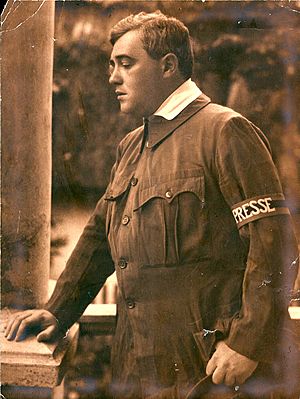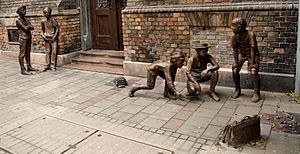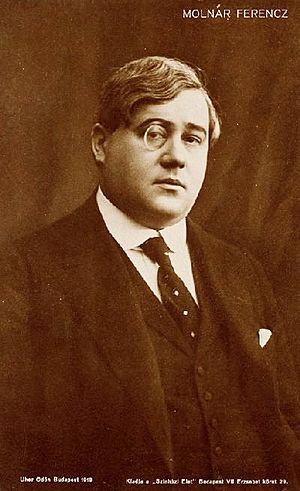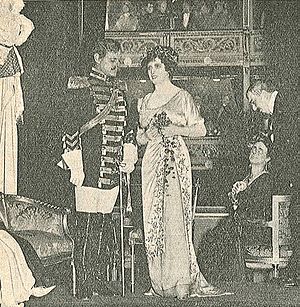Ferenc Molnár facts for kids
Quick facts for kids
Ferenc Molnár
|
|
|---|---|

Portrait by Carl Van Vechten, 1941
|
|
| Born | Ferenc Neumann 12 January 1878 Budapest, Austria-Hungary (today Hungary) |
| Died | 1 April 1952 (aged 74) New York City, New York, |
| Resting place | Linden Hill Cemetery, Ridgewood, Queens |
| Occupation | Novelist |
| Years active | 1901–1952 |
| Spouse | Margit Vészi (1906–1910; divorced; 1 child) Sári Fedák (1922–1925; divorced) Lili Darvas (1926–1952; his death) |
| Children | Marta Molnar Sarkozi (1907–1966) |
Ferenc Molnár (born Ferenc Neumann; January 12, 1878 – April 1, 1952) was a famous Hungarian writer, stage director, and playwright. He is known as one of Hungary's most celebrated playwrights. His main goal was to entertain people by turning his own experiences into amazing stories and plays.
Molnár didn't stick to just one writing style. He used ideas from different movements like naturalism and romanticism. He was very good at mixing Hungarian storytelling with ideas from Western countries. This made his writing style truly unique.
As a novelist, Molnár is perhaps best known for his book The Paul Street Boys. This story is about two rival groups of kids in Budapest. It has been translated into many languages and made into plays and movies. Many people consider it a masterpiece.
However, Molnár made his biggest mark as a playwright. He is famous around the world for his plays. His plays often mixed realism with fantasy, and humor with serious feelings. Some of his most lasting plays include The Devil, Liliom, The Swan, The Guardsman, and The Play's the Thing. Writers like Oscar Wilde and George Bernard Shaw influenced him.
Molnár moved to the United States to escape the persecution of Hungarian Jews during World War II. He later became an American citizen. His plays are still performed all over the world today. He inspired many other Hungarian playwrights.
Contents
Life
Early years
Ferenc Molnár was born in Budapest, Hungary, on January 12, 1878. His father, Dr. Mór Neumann, was a successful doctor. His mother was Jozefa Wallfisch. Their home was grand but often quiet. Young Ferenc was told to be quiet a lot, even though he was a lively child.
In 1887, Molnár started high school at the Református Gimnázium. Here, he became interested in learning new languages. His talent for writing also began to show. When he was 14, he started his own small newspaper called Haladás (Progress). He also wrote a play called Kék barlang (Blue Cave). He directed and staged this play in a friend's basement.
After high school, Molnár studied law at the University of Budapest in 1895. His father then sent him to Geneva, Switzerland, to continue his studies. While in Geneva, he wrote a lot and sent his work to different newspapers. He also wrote a short novel called Magdolna. He visited Paris to see new plays, which greatly influenced his writing style.
In 1896, Molnár decided to stop studying law and become a full-time journalist. He wrote about many topics, but he mostly covered court trials for a newspaper called Vészi's Budapesti Napló. His first wife, Margit Vészi, was the daughter of the newspaper's editor. Molnár's mother passed away in 1898 when he was 20. During World War I, Molnár worked as a war correspondent. He wrote positive reports about the war and was even honored by the emperor. He later wrote a book about his war experiences.
Literary and theatrical career
In 1901, Molnár published his first full-length novel, Az éhes város (The Hungry City). This book made him well-known in Hungary. It showed the bad effects of money through the eyes of a young journalist.
The year after his novel came out, Molnár started writing for the theater. This is where he became famous internationally. His early plays were influenced by his work as a journalist. His first play, A doctor úr (The Lawyer), was a comedy.
Molnár's personal life often inspired his writing. After separating from his first wife, he had relationships that influenced some of his most successful works.
In 1907, Molnár wrote Az ördög (The Devil). This play brought him international fame. It was performed all over Europe and in New York. The Devil was later made into a film. Also in 1907, Molnár wrote A Pál-utcai Fiúk (The Paul Street Boys).
His fame grew even more with the success of his play Liliom abroad. Even though it wasn't a big hit in Budapest at first, it became his most famous play. Liliom was made into a film by Fritz Lang in 1934. Later, it became a famous Broadway musical called Carousel in 1945.
Molnár faced personal challenges that affected him deeply, but he continued to write. Between 1910 and 1914, he published several collections of his essays. He also translated over 30 French plays. Molnár worked very hard throughout his life. Writing was a way for him to express his inner thoughts and feelings for over 50 years.
Later years and death
On January 12, 1940, Molnár moved to America. He spent the last 12 years of his life living in the Plaza Hotel in New York. In 1943, he had a serious heart attack. This made him stop working for almost a year. To celebrate the end of World War II, Molnár wrote and published Isten veled szivem (Farewell My Heart).
After the war, Molnár became very sad and upset. He learned what happened to his Jewish friends and colleagues. This changed his personality, and he became more quiet and withdrawn.
In 1947, Molnár experienced a great sadness when his secretary and close friend, Wanda Bartha, passed away. This event had a lasting impact on him. After her death, he wrote Companion in Exile. This was his most tragic work, where he remembered his friend's sacrifices and their time together. Molnár gave all his writings and scrapbooks to the New York Public Library. Wanda Bartha had prepared these scrapbooks for him.
Ferenc Molnár died from cancer on April 1, 1952, at the age of 74. He passed away at Mount Sinai Hospital in New York City. He was superstitious and feared that making a will would make him die sooner. Because of this, he left behind several unfinished works and a lot of money without a will. Only his wife, Lili Darvas, and a few close friends attended his funeral. Lili Darvas said goodbye to him with a line from his play Liliom: "Liliom, sleep my boy, sleep!"
Selected works
Plays
- The Lawyer (1902)
- Jozsi (1904)
- The Devil (1907)
- Liliom (1909)
- The Guardsman (1910)
- The Tale of the Wolf (1912)
- The White Cloud (1916)
- Carnival (1916)
- Fashions for Men (1917)
- The Swan (1920)
- The Play's the Thing (1926)
- Olympia (1928)
- One two three (1929)
- The Good Fairy (1930)
- Delicate Story (1940)
- The King's Maid (1941)
Books
- The Hungry City (1901)
- The Paul Street Boys (1906)
- The Memoirs of a War Correspondent (1916)
- The Captain of St. Margaret's (1926)
- Farewell My Heart (1945)
- Companion in Exile: Notes for an Autobiography (1950)
See also
 In Spanish: Ferenc Molnár para niños
In Spanish: Ferenc Molnár para niños






